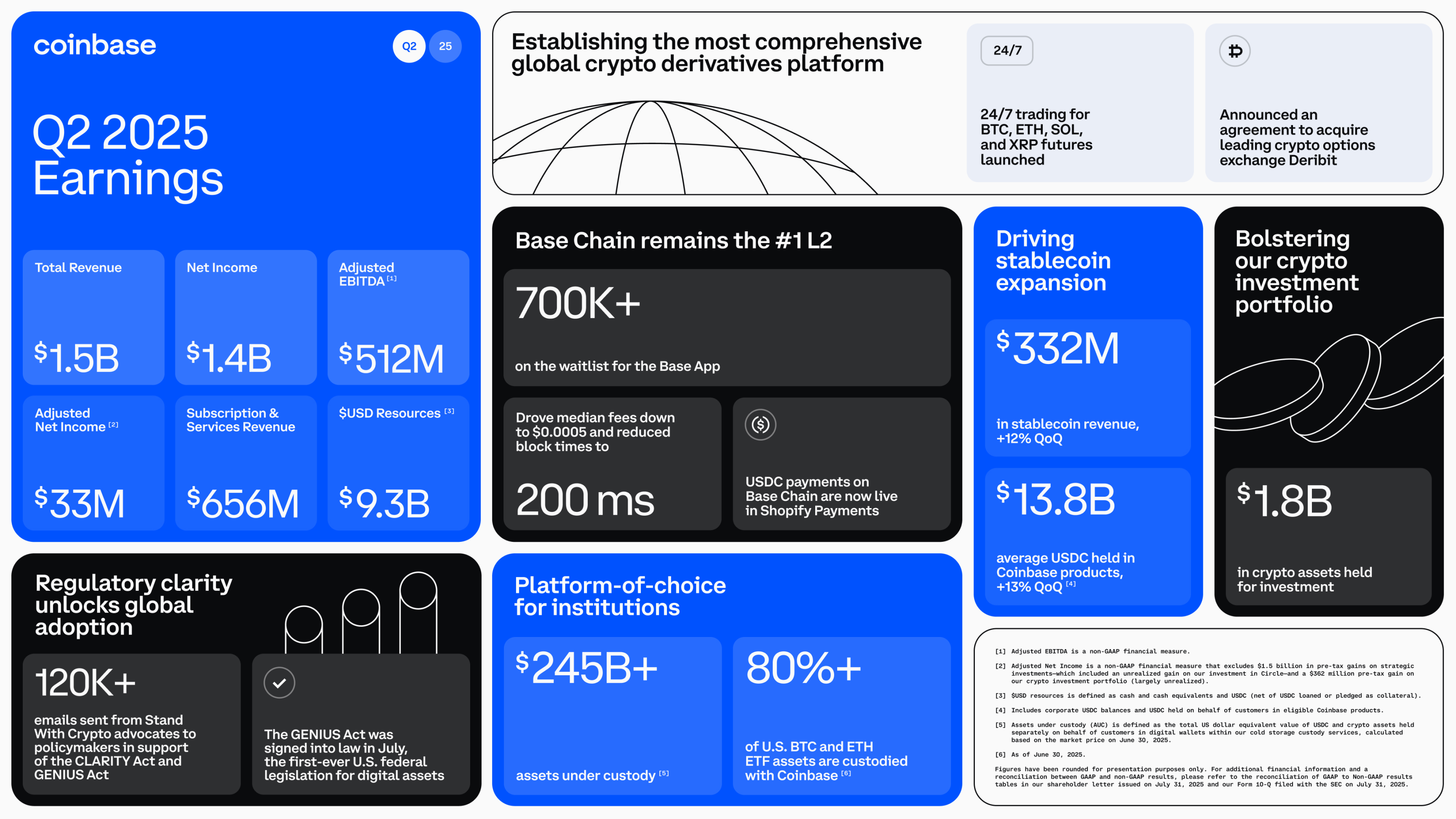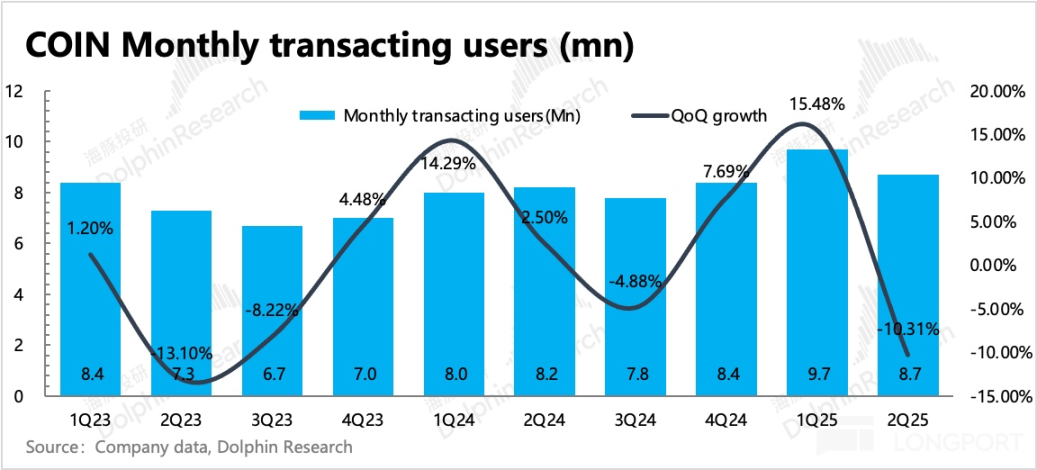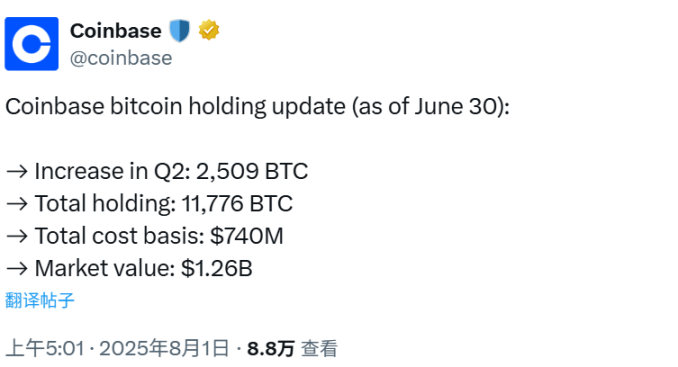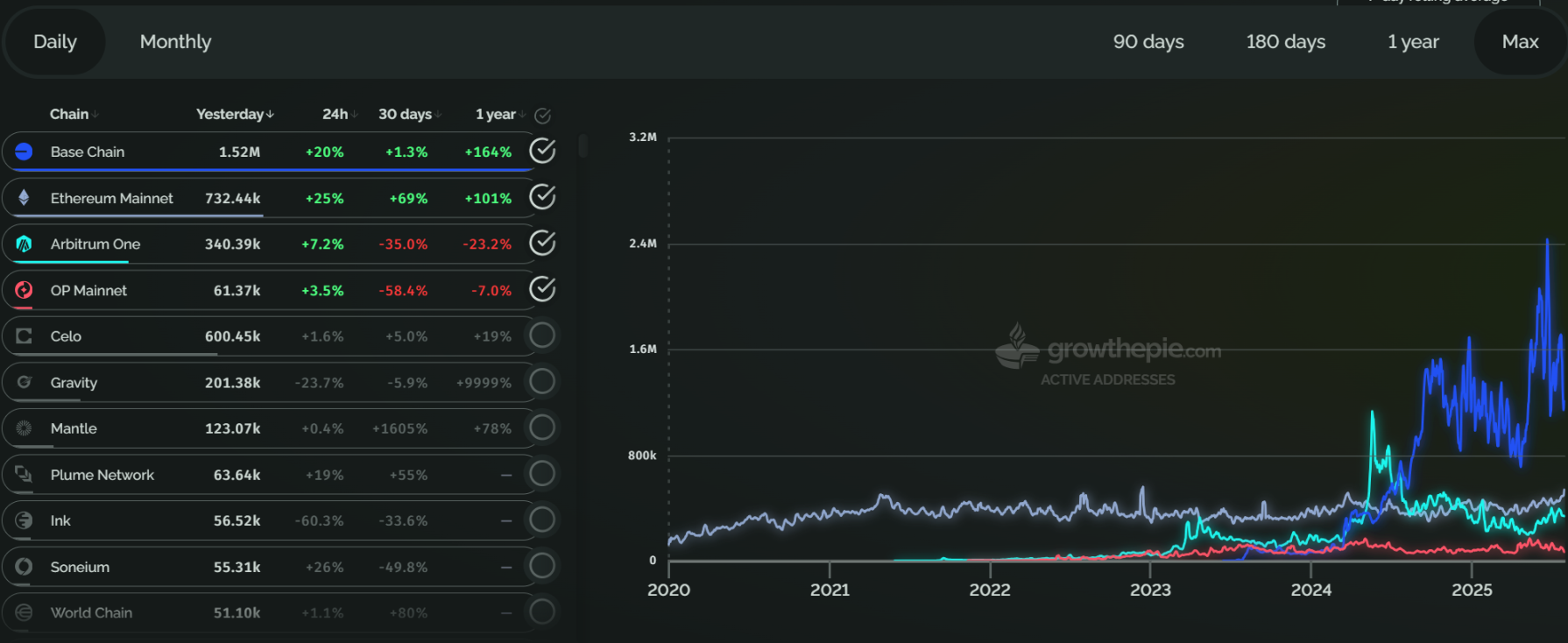Original Author: 1912212.eth, Foresight News
On August 1, Coinbase, the largest cryptocurrency exchange platform in the United States, released its second-quarter financial report, revealing its overall performance for Q2 this year: a net profit of $1.43 billion, far exceeding the $36 million from the same period last year. The total trading volume was $237 billion, slightly up from $226 billion in the same period of 2024. Compared to Q1, trading revenue fell by 39%, and spot trading volume decreased by over 30%. Notably, a previously reported user data breach ultimately resulted in a loss of $307 million.

After the financial report was released, according to stock market data, its stock price fell over 9% in after-hours trading to $377.7, and subsequently declined for several days, reaching a low of $314.
Significant Decline in Spot Trading Volume, BTC Holdings Exceed 11,000
Coinbase's latest financial report shows that total revenue for Q2 this year was $1.5 billion, a year-on-year increase, but below analysts' expectations of $1.59 billion. The net profit was $1.4 billion, but this mainly included $1.5 billion in unrealized gains from strategic investments and $362 million in unrealized gains related to crypto assets. After excluding these impacts, the adjusted net profit was $33 million.
In terms of major revenue contributions, Coinbase has three main sources of income: trading revenue, subscription revenue, and others.
Trading revenue was $764 million, a year-on-year decrease of 39%, far below market expectations. Overall trading volume fell by 40% compared to the previous quarter, with retail trading down 45% and institutional trading down 38%. Retail trading revenue was $650 million (with a trading volume of $43 billion), institutional trading revenue was $60.8 million (with a trading volume of $19.4 billion), and other trading revenue was $54 million. The number of trading users in Q2 decreased by 1 million compared to the previous quarter, falling to 8.7 million. This was mainly due to panic among existing users, with the average trading scale dropping by 38%, leading to a dismal trading volume.

Subscription and service revenue: $656 million, a decrease of 6% compared to the previous quarter. Stablecoin revenue (mainly USDC) was $333 million (up 12% quarter-on-quarter), with an average USDC balance of $13.8 billion on the Coinbase platform and $47.4 billion off-platform.
Staking rewards were $145 million (down 26% quarter-on-quarter), interest and financial fee income was $59.3 million (down 6% quarter-on-quarter), and other subscription and service revenue was $120 million (down 15% quarter-on-quarter).
As of the end of Q2, Coinbase had $9.3 billion in USD resources, a decrease of $590 million, or 6%, from the previous quarter. This decline was mainly due to an increase in fiat currency loans and purchases of our crypto asset portfolio. Cash and cash equivalents amounted to $1.449 billion, net USDC was $1.784 billion, money market funds were $5.98 billion, and cash held on third-party platforms was $110 million.

Official tweets indicate that Coinbase purchased 2,509 BTC in Q2, bringing its total BTC holdings to 11,776 BTC, with a total cost of $740 million and a current value of $1.26 billion.
Aggressive Acquisitions and Diverse Business Development
As a publicly traded company in the U.S., its current product line includes the main Coinbase platform, Coinbase Pro (now Coinbase Advanced), Coinbase Wallet, Coinbase Card, Coinbase Earn, Coinbase Cloud, etc., covering various aspects such as retail and institutional services, trading and custody, DeFi and payments.
Moreover, Coinbase has recently intensified its acquisition efforts, venturing into multiple fields. On July 29, Bloomberg reported that Coinbase was in advanced negotiations to acquire the Indian crypto trading platform CoinDCX. However, CoinDCX CEO Sumit Gupta quickly denied this, stating that the company would not be sold.
On July 11, Coinbase completed a talent acquisition, specifically targeting Opyn CEO Andrew Leone and research head Joe Clark. Leone and Clark will now join the Onchain Markets team, which operates within Coinbase's institutional organization, focusing on verified pools and other on-chain market product development plans.
However, the largest acquisition event occurred in May this year, when Coinbase officially confirmed its acquisition of the cryptocurrency options platform Deribit to unify spot, futures, and options trading. The acquisition price was approximately $2.9 billion, including $700 million in cash and 11 million shares of Coinbase Class A common stock, further strengthening its position in the options and derivatives market. Additionally, it recently acquired Liquifi (a token management platform) to enhance its asset management and token issuance capabilities.
Furthermore, Coinbase has partnered with traditional financial institutions such as JPMorgan Chase, PNC Bank, and American Express to promote services like user deposits and rewards point conversions to USDC.
Coinbase's financial report indicates that Base is one of the largest distribution networks for USDC, with the vast majority of P2P transactions on Base completed using USDC. The Base app has now entered public testing, integrating features such as wallets, trading, payments, social networking, gaming, and DApps. According to the latest data from growthepie, its number of active addresses far exceeds those of OP and Arbitrum.

In terms of policy compliance, after the U.S. SEC withdrew its lawsuit in February this year, Coinbase obtained a MiCA license in Luxembourg in June, authorizing it to provide core retail and institutional services in 30 member countries of the European Economic Area, paving the way for its entry into the European market.
Future Bets on Prediction Markets and Tokenized Stocks
Coinbase's ambitions will continue to span multiple fields.
Today, Coinbase's Vice President of Product, Max Branzburg, revealed to CNBC that Coinbase is about to expand its service offerings for U.S. users, creating a "one-stop trading platform" that includes tokenized stocks, prediction markets, early token sales, and more. A video released by Coinbase's official Twitter echoed this sentiment.

However, in the prediction market space, Coinbase will face competition from Kalshi, the only federally licensed prediction market platform in the U.S., as well as the globally leading Polymarket—this company plans to re-enter the U.S. market after recently acquiring the licensed derivatives trading platform QCEX.
Additionally, Coinbase's tokenized stock product will compete with similar offerings from Robinhood, as well as other cryptocurrency trading platforms like Gemini and Kraken, although these companies' products are currently only available to investors outside the U.S.
免责声明:本文章仅代表作者个人观点,不代表本平台的立场和观点。本文章仅供信息分享,不构成对任何人的任何投资建议。用户与作者之间的任何争议,与本平台无关。如网页中刊载的文章或图片涉及侵权,请提供相关的权利证明和身份证明发送邮件到support@aicoin.com,本平台相关工作人员将会进行核查。




